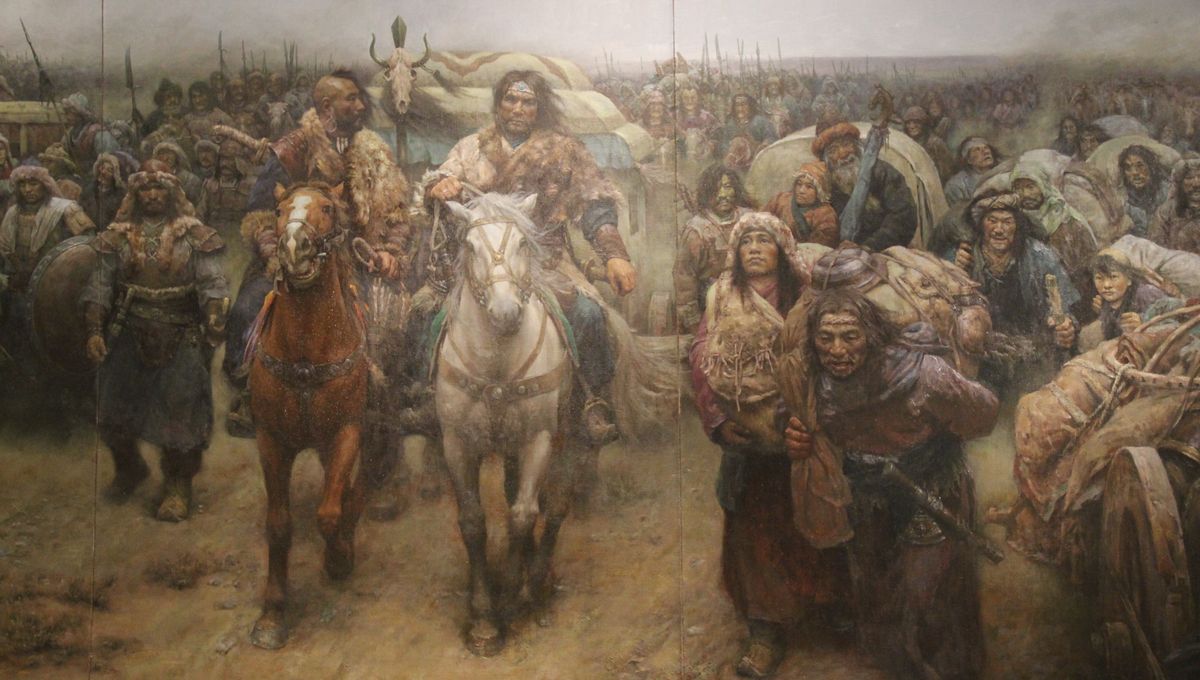
Painstaking archaeological research and new DNA evidence has revealed fascinating insights into the Xiongnu empire, the world’s first nomadic imperial power. The research not only shows how ethnically diverse this empire was, but also the critical role princesses played in building its political structure.
The Xiongnu empire arose on the Mongolian steppe around 2,500 years ago, which is about 1,500 years before the Mongols. These historically enigmatic people were one of the most powerful Iron Age forces at the time, as their reach and influence extended as far as Egypt, to Rome, to Imperial China.
In fact, it was the Xiongnu’s repeated invasions of China that prompted the creation of the Great Wall. But despite their significance we do not know much about them, as they were not a literate society and they have left little physical evidence of their daily lives.
Most of what we know about Xiongnu history and social structure comes from second-hand descriptions by their Chinese foe. These accounts tell us little about their origins or political structure and governance. For instance, were they centrally controlled or were they a loose confederation of different tribes?
Research conducted over the last few decades has shown how the Xiongnu emerged as a political entity through a sudden migration and mixing of various nomadic groups in northern Mongolia in around 200 BCE, but such findings obscure more than they reveal.
To address this, an international team of researchers undertook a genetic investigation of two elite Xiongnu cemeteries located on the western frontier of the empire. One of the cemeteries was that of an aristocratic elite at Takhiltyn Khotgor and a local elite cemetery at Shombuuzyn Belchir.
“We knew that the Xiongnu had a high degree of genetic diversity, but due to a lack of community-scale genomic data it remained unclear whether this diversity emerged from a heterogeneous patchwork of locally homogenous communities or whether local communities were themselves genetically diverse,” explains Juhyeon Lee, first author of the study and PhD student at Seoul National University, in a statement.
“We wanted to know how such genetic diversity was structured at different social and political scales, as well as in relation to power, wealth, and gender.”
The team found that those buried in the two cemeteries showed extremely high genetic diversity, which was comparable to that found across the Xiongnu empire more generally. This high genetic heterogeneity was present at all levels of their society, within individual communities as well as individual families, confirming the view that the empire was multiethnic. But this diversity was more apparent among those of lower status, whose graves were located around elite burials, suggesting that these individuals came from distant parts of the empire.
Local aristocratic elites, on the other hand, appeared to be less genetically diverse and exhibited higher proportions of eastern Eurasian ancestries. This could mean that elite status and power was held by specific genetic subsets within the Xiongnu empire. But despite this, it is clear that even elite families used marriage to secure connections between newly incorporated groups.
“We now have a better idea of how the Xiongnu expanded their empire by incorporating disparate groups and leveraging marriage and kinship into empire building,” says senior author Choongwon Jeong, Associate Professor of Biological Sciences at Seoul National University.
In addition to these findings, the team also discovered that the high-status and elite Xiongnu burials were mostly associated with women. This confirms textual and archaeological evidence that women played a crucial role in the expansion of the empire. At the grave site at Takhiltyn Khotgor, the team found that monumental tombs had been constructed for women, who were flanked by males buried in simple graves.
These women had elaborate coffins decorated with the golden sun and moon emblems of the Xiongnu empire. One woman’s tomb even contained six horses and the remains of a chariot. Women also occupied the most elaborate graves at the cemetery of Shombuuzyn Belchir.
“Women held great power as agents of the Xiongnu imperial state along the frontier, often holding exclusive noble ranks, maintaining Xiongnu traditions, and engaging in both steppe power politics and the so-called Silk Road networks of exchange,” added Bryan Miller, project archaeologist and Assistant Professor of Central Asian Art & Archaeology at the University of Michigan.
This study has provided valuable insights into the power of the Xiongnu empire and even shows how enduring their culture was.
“Our results confirm the long-standing nomadic tradition of elite princesses playing critical roles in the political and economic life of the empires, especially in periphery regions – a tradition that began with the Xiongnu and continued more than a thousand years later under the Mongol Empire,” says Jamsranjav Bayarsaikhan, project archaeologist at the Max Planck Institute for Geoanthropology.
“While history has at times dismissed nomadic empires as fragile and short, their strong traditions have never been broken.”
The study is published in Science Advances.
Source Link: Princesses Played Critical Role In The Diversity Of Mongolia’s First Nomadic Empire